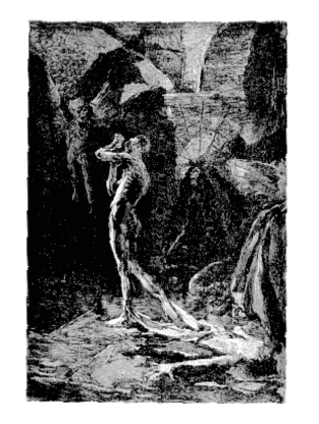ADSactly Literature: The Count of Lautréamont or a Literature of the Future (Part I)

In closing the section of my work that corresponds to the French progenitors of modern poetry, who played a fundamental role in what has become the subsequent and contemporary poetic art, as I announced in previous post, it is up to us to address what is known as Count of Lautréamont, whose figure and work continue to create contradictory reactions even today, and who has had a major influence on Western poetic modernity, since he contributed to renewing poetry, until he was considered a precursor of the twentieth-century literary movement known as Surrealism.
Aspects of his biography
"Count of Lautréamont" is the pseudonym of Isidore Ducasse, who was born in Montevideo (Uruguay) in 1846. Two hypotheses are known about the origin of his pseudonym. One is that he took it from the novel Latréaumont by Eugène Sue, a famous French writer of the 1840s, known for his folk novels The Mysteries of Paris and The Wandering Jew; the character who could be a reference for the pseudonym is a Norman conspirator raised against Louis XIV. The other hypothesis is rather linguistic: Lautréamont ("l'autre à Mont") would mean "the other at Mont(evideo)".
He was the son of an official of the French Consulate in Uruguay. His mother, also French, died when the poet was two years old. He lived in Montevideo until he was 14, when he was sent by his father to France. He studied in schools in Tarbes and then in the Polytechnic School of Paris. In 1867, at the age of 20, he starts writing the book that will mark the history of contemporary literature, The Songs of Maldoror. In 1868 he published the first song in which he uses three asterisks as his signature. Later, in 1869, the complete version was published under the aforementioned pseudonym, but the publisher did not dare to circulate it, and gave twenty copies to the author. In a letter the writer declared: "he refused to make it appear because life was painted in very bitter colours and he was afraid of the attorney general".
In 1870 he published, under his real name, Poetries, a collection of fragmentary texts, in the style of aphorisms and thoughts, in which Isidore Ducasse presents his paradoxical ideas about literature, human behaviour and life in general. In the same year, very young, he died in Paris, allegedly as a result of a malignant fever.
Not much is known about his life, and even his death is marked by unknown features (a rumour said that he had been killed on the orders of Napoleon III). In a testimony of a fellow student of his, he is described as "usually sad and silent, with a distant attitude" (Pellegrini).

Information on The Songs of Maldoror and assessment in his time
The central work of Lautréamont, as it is usually called, is marked by a very particular history. After the unreleased edition, a Belgian bookseller who managed to get hold of a part of it, shows it in 1885 to a writer member of the literary group La jeune Belgique, who makes it known among his colleagues, those who perceive the genius of the book. He arrives in France where Léon Bloy will start its timid diffusion in 1887, although with a not very favourable attitude (he treats it as a "monstrous book"), and then Remy de Gourmont in 1891. There is a long period of ignorance of the book, until in 1920 the poet Blaise Cendrars achieves a new edition. And the surrealists welcomed the book and the poet with great enthusiasm.
The work of Lautréamont, as scholars have pointed out, did not find an immediate reception in France, since perhaps the formalism derived from Parnassianism, and then a certain aestheticism of the Symbolist school deprived in the indifference or prejudiced reading of his work, which even came to be deluded by illness and insanity. The 20th century would have to come for her to be appreciated as she deserved.
However, one of the first comments on The Songs of Maldoror, which appeared in a newspaper of the time, perhaps written by one of the few who managed to assess Ducasse's work positively, largely synthesizes its relevant features:
The first effect produced by this book is astonishment: the hyperbolic emphasis of the style, the wild singularity, the desperate vigour of the ideas, the contrast of that desperate language with the insulting lucubrations of our time, throw our spirit into a deep stupor (quoted by Pellegrini).

Characterization of the art of the Count of Lautréamont
Philosophical conception
Preceded by this condensed critical appreciation, we will go on to point out some main aspects, in which the influences assimilated by Lautréamont will slip in.
The "profound astonishment" is perhaps produced, first of all, by that expression of evil, seen in two senses, which had had a relevant consideration in French Romanticism and then in Baudelaire.
On the one hand, the experience of decadence, which the Romantic writer Alfred de Musset had described as the "evil of the century". With this expression he wanted to synthesize the set of concerns or motives that marked the second half of the nineteenth century: uncertainty of the future, rejection of the past, disbelief and despair, but also contempt for the spirit identified as "bourgeois", and a very pronounced interest in adventure and fantasy (Pellegrini).
This atmosphere triggered in some writers a "spirit of revolt" that took shape in the so-called "Satanism", by identifying with the rebellious angel, Satan, who, according to the biblical texts, rebels against God. And here we link up with the other sense of evil, which had had one of its highest manifestations in Baudelaire.
Now, as the above-mentioned critic points out, in Baudelaire the exaltation of evil and the diabolic remain within a certain order and measure, while in Lautréamont the measure and balance, which leads to nothingness, are lost.
This awareness will be expressed in the personage-spoken Maldoror, as we shall see later, who sees in the human condition the cause of the evils of the world, responsible for the cruelty that characterizes it. And, by induction, to God, as we read in the Second Canto:
My poetry will consist in attacking man, that wild beast, and the Creator, who should not have generated that carrion.
He joins this "cry of resistance against domestication", which makes him similar to his contemporary Rimbaud, and, later, with the ideas of the German philosopher Nietzsche, who confronts the "morality of submission". In Lautréamont, we will have a personality that fights against the coercion and imposition of all kinds of power, as well as its paralyzing effect on the will and emotion.
(Continues...)
Bibliographical references
Count of Lautréamont (1979). Complete works (3rd ed.). Introduction and translation: Aldo Pellegrini. Spain: Edit. Argonauta.
Friedrich, Hugo (1974). Structure of modern lyric. Spain: Edit. Seix Barral.
https://en.wikipedia.org/wiki/Comte_de_Lautr%C3%A9amont
Written by @josemalavem
Click the coin below to join our Discord Server
)
nice post
Thank you, @mahabul19.
Lautréamont is one of those writers who, despite his little work, managed to achieve literary fame after his death. Likewise, like other great writers, his work was rejected at first, as you well point out. Only time has vindicated this author, the father of modern poetry. A new author, new references and new poems. I await the continuation of this series. Greetings
I appreciate your reading and commentary, @nancybriti. Lautréamont escapes us many times, as it did in his time, despite the fact that a century later much of what he concretized in his vision and style is what has allowed today's literature to be. Until the next post.
Hi, @adsactly!
You just got a 0.27% upvote from SteemPlus!
To get higher upvotes, earn more SteemPlus Points (SPP). On your Steemit wallet, check your SPP balance and click on "How to earn SPP?" to find out all the ways to earn.
If you're not using SteemPlus yet, please check our last posts in here to see the many ways in which SteemPlus can improve your Steem experience on Steemit and Busy.